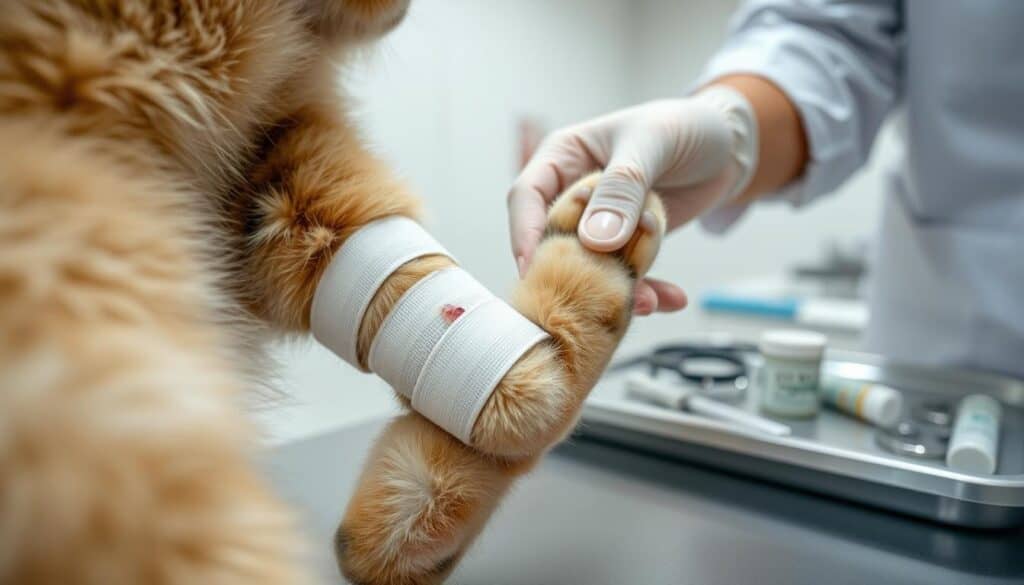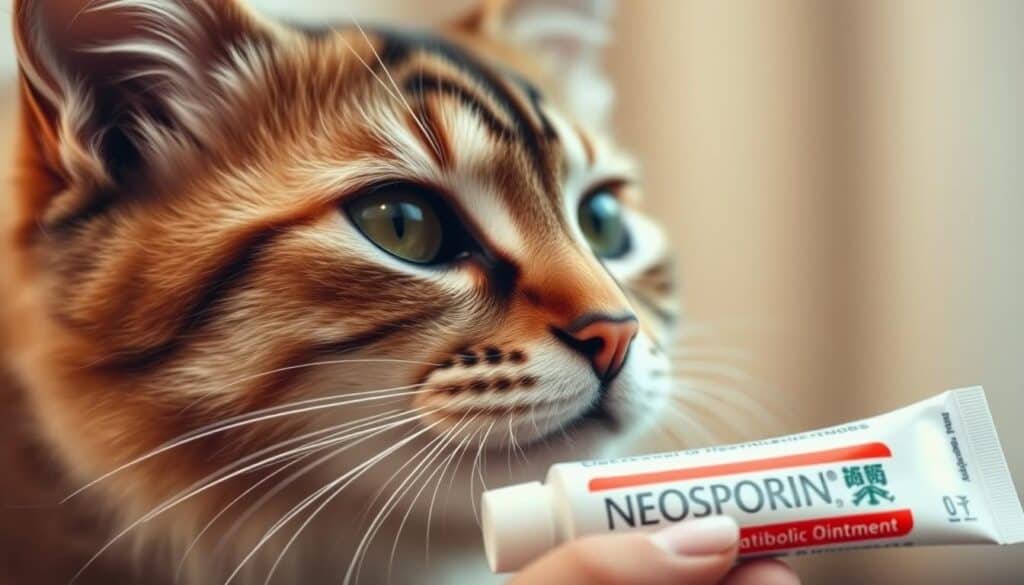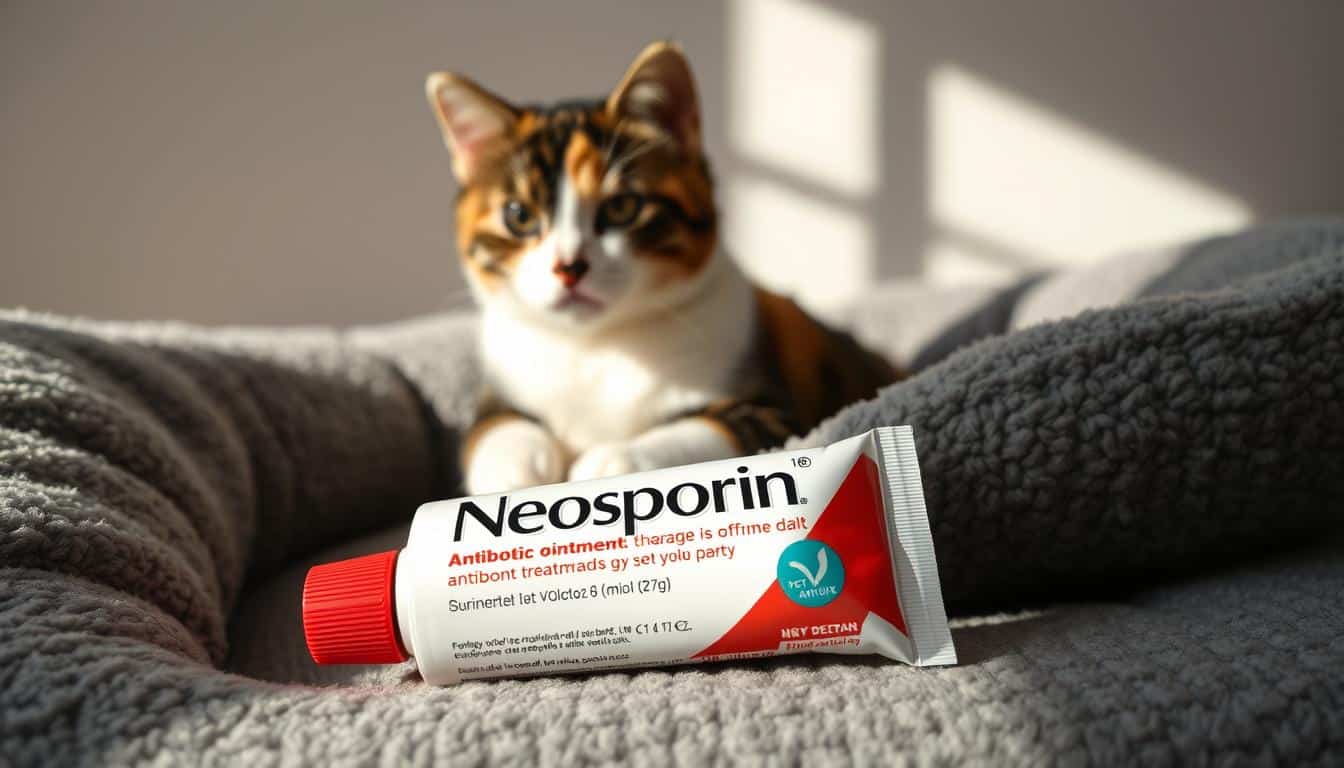Many pet owners wonder if Neosporin is safe and effective for cats. This antibiotic ointment works well for humans but raises questions for cat care. Is it safe for cats? What are the benefits and risks?
This article will guide you on using Neosporin for cat health. We’ll look at its use in treating wounds. By following veterinary advice and expert insights, you can make the best choices for your cat.
Key Takeaways
- Applying Neosporin on cats should be approached with caution.
- Understanding cat wound care is key for effective treatment.
- Know the benefits and risks of Neosporin for feline injuries.
- Always consult a vet before using any ointment on cats.
- Look into other options along with Neosporin for your cat’s health.
Understanding Neosporin and Its Uses
Neosporin is a well-known antibiotic ointment for humans. It’s used to treat minor wounds. The ointment has three active ingredients: neomycin, polymyxin B, and bacitracin. These work together to fight off many bacterial infections, making it great for wound care.
What Is Neosporin?
This ointment creates a barrier against bacteria and helps wounds heal faster. It’s a key part of wound care in many homes. It prevents infections in small cuts, scrapes, and burns, helping the body heal naturally.
Common Uses of Neosporin in Humans
Health groups often suggest Neosporin for wound care because it works well. People use it on minor injuries to lower infection risk. Neosporin fights a wide range of bacteria, making it a common first aid item. Its easy use and role in healing are valued by many.
Can You Put Neosporin on a Cat?
Many pet owners wonder if they can use Neosporin on their cats. This ointment is often used on humans but can be risky for cats. Knowing the benefits and risks helps owners make the best choice for their cat’s care.
Potential Benefits of Using Neosporin on Cats
Neosporin can help prevent infections and aid in healing for cats. It fights bacteria at the wound site, reducing infection risk. For minor cuts or scrapes, it can speed up healing by keeping the area moist and clean.
Some cat owners see better results with Neosporin than without any treatment. This makes it a popular choice for minor wounds.
Risks and Considerations
While Neosporin has benefits, there are risks to consider. Cats may be allergic to some ingredients, causing skin irritation. They can also get sick if they ingest it, as it contains harmful antibiotics.
Vets usually advise caution with Neosporin for cats. They suggest talking to a vet before using it on your pet. This ensures your cat’s safety and well-being.
Is Neosporin Safe for Cats?
It’s important for pet owners to know if Neosporin is safe for cats. Many wonder if Neosporin is okay for cats. This antibiotic can be risky if not used right, leading to Neosporin toxicity in cats. Knowing the risks and when not to use it helps keep cats healthy.
Understanding Toxicity Levels
Neosporin has ingredients that might not be good for all animals. Some parts can help with minor cuts, but there’s a risk of toxicity. Cats are extra sensitive to some ingredients in ointments. If they ingest it or use too much, they could have serious reactions. So, it’s key to watch closely when applying it.
When Not to Use Neosporin on Felines
There are times when you should not use Neosporin on cats. For example, deep wounds, puncture wounds, or animal bites. Using it in these cases can hide how bad the injury is. Always think about your cat’s health first and talk to a vet before using Neosporin.
How to Heal an Open Wound on a Cat
When a cat gets an open wound, it’s important to know how to treat it. First aid for cats means acting fast to reduce pain and prevent more harm. Pet owners should learn basic cat wound care to handle minor injuries well. These simple steps can help the healing process.
Steps for Immediate First Aid
First, check the injury to see how bad it is. Clean the wound with lukewarm water to get rid of dirt. Don’t use hydrogen peroxide or alcohol, as they can hurt the skin.
After cleaning, cover the wound with a sterile dressing or bandage. This protects it from getting infected. Keep changing the dressing and watch for signs of infection.
Signs of Infection to Watch For
It’s key to watch the wound closely as it heals. Look for signs like swelling, redness, or pus. A bad smell and sensitivity around the wound are also warning signs.
If you see any of these, get vet help fast. Quick action is vital in treating a cat’s open wound.

Alternatives to Neosporin for Cats
There are many alternatives to Neosporin for treating cat wounds. These options are safer and made just for cats. They help wounds heal well and avoid problems.
Best Antibiotic Ointment for Cats
Many products are great for cats. Brands like Veterniary Science and Animax make special ointments. These ointments help wounds heal without harming cats.
Always check the labels to make sure they’re right for your cat.
Prescription Options from a Veterinarian
For serious wounds or infections, vet prescriptions are best. These medicines are made just for your cat’s problem. A vet can give you the best advice for your cat.
Using vet-prescribed ointments can help your cat heal faster and feel better.
Can You Use Neosporin on Cats? A Detailed Examination
Deciding if you can use Neosporin on cats needs careful thought. Neosporin might help with small cuts or scrapes in some cases. But, it’s always best to be cautious. Getting advice from a vet is key to keeping your cat healthy.
When Neosporin May Be Appropriate
Neosporin might be okay for small, shallow wounds. These are usually minor cuts or scrapes that are clean and not infected. The antibiotic in Neosporin can help stop infections. But, each case is different, and a vet should check the wound first.
Consulting a Veterinarian
Talking to a vet before using Neosporin is very important. They can give advice based on your cat’s health and the wound. Even small wounds can have hidden problems. A vet can make sure the treatment is right for your cat.

How to Apply Neosporin on Cats Safely
When a cat gets a wound, it’s important to treat it right to help it heal and avoid infection. Knowing how to use Neosporin on cats is key. This includes steps to keep the process safe and effective. Here, we’ll talk about how to get ready for treatment and the right way to apply it.
Preparing the Wound
Before you start with Neosporin, you need to prepare the wound. First, trim the hair around the wound to keep it clean. Then, use mild soap and warm water to clean the area. This removes dirt and gets it ready for treatment.
After cleaning, dry the area with a clean cloth. This makes sure the Neosporin sticks well.
Application Techniques
When applying Neosporin, it’s important to do it gently to avoid hurting your cat. Use a clean finger or a sterile applicator to put a thin layer on the wound. Don’t press too hard, as it might hurt.
Keep an eye on the area after applying Neosporin for any signs of irritation. Following these steps helps your cat heal faster and more comfortably.
Additional Tips for Cat Wound Care
Managing a cat’s wound requires some key tips. Always check the wound for healing signs or complications like redness, swelling, or discharge. Keeping it clean and dry is important. Make sure she doesn’t lick or scratch it too much, as this can slow healing and bring in bacteria.
Good feline first aid means creating a safe space for your cat. This helps them feel less stressed, which is good for their health. Use vet-approved cleaners to gently clean the wound. This helps it heal without getting irritated.
Regular vet visits are also key for cat health. They help catch any problems early and give you peace of mind. If you see signs of infection or if the wound doesn’t get better in a few days, get professional help. This ensures your cat gets the best care.




